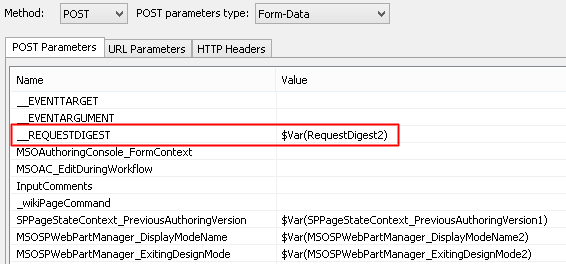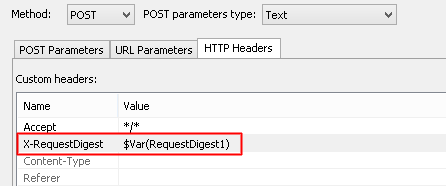Testing of SharePoint Applications
After you install the Module for SharePoint Testing on a computer running
WAPT or
WAPT Pro Workplace, you will be able to test web applications based on SharePoint platform.
SharePoint applications use special tokens called "request digest" or "form digest"
to validate POST requests to SharePoint. There are several ways to transfer the Request Digest value in the server response:
![]() Response to the SOAP request
Response to the SOAP request
![]() Responses to the REST API or JSON requests
Responses to the REST API or JSON requests
![]() X-RequestDigest response header
X-RequestDigest response header
![]() AJAX UpdatePanel Controls
AJAX UpdatePanel Controls
![]() Hidden fields of server response
Hidden fields of server response
The Module for SharePoint Testing has a special function
$RequestDigest
which can find any of these Request Digest values in server responses
and automatically parameterize them.
-
Response to the SOAP request
In the SOAP approach the response body looks something like:
<?xml version="1.0" encoding="utf-8"?> <soap:Envelope xmlns:soap="http://schemas.xmlsoap.org/soap/envelope/" xmlns:xsi="http://www.w3.org/2001/XMLSchema-instance" xmlns:xsd="http://www.w3.org/2001/XMLSchema"> <soap:Body> <GetUpdatedFormDigestInformationResponse xmlns="http://schemas.microsoft.com/sharepoint/soap/"> <GetUpdatedFormDigestInformationResult> <DigestValue>0x1122334455 ... FF,27 Jul 2015 03:06:54 -0000</DigestValue> <TimeoutSeconds>1800</TimeoutSeconds> <WebFullUrl>$(SPWebUrl)</WebFullUrl> <LibraryVersion>16.0.3208.1222</LibraryVersion> <SupportedSchemaVersions>14.0.0.0,15.0.0.0</SupportedSchemaVersions> </GetUpdatedFormDigestInformationResult> </GetUpdatedFormDigestInformationResponse> </soap:Body> </soap:Envelope>The Module for SharePoint Testing extracts the Request Digest value from the DigestValue block.
-
Responses to the REST API or JSON requests
In the REST approach the response body looks like the following:{ "FormDigestTimeoutSeconds" : 1800, "FormDigestValue" : "0x1122334455 ... FF,27 Jul 2015 03:06:54 -0000", "LibraryVersion" : "16.0.4230.1217", "SiteFullUrl" : "$(SPSiteUrl)", "SupportedSchemaVersions" : ["14.0.0.0", "15.0.0.0"], "WebFullUrl" : "$(SPWebUrl)" }The Module for SharePoint Testing extracts the Request Digest from the FormDigestValue property.
In case of JSON requests the module also extracts the Request Digest value from the FormDigestValue property and creates the corresponding variable:

-
X-RequestDigest response header
Request Digest values can be transferred in the headers of server response to a POST request. The Module for SharePoint Testing finds the X-RequestDigest value in the header and creates the corresponding variable:

-
AJAX UpdatePanel Controls
In this case you will see the Request Digest values in the code of server response in the following way: |__REQUESTDIGEST|. The Module for SharePoint Testing will extract the |__REQUESTDIGEST| parameters from the responses and correctly parameterize them.
- Hidden fields of server response
The Module for SharePoint Testing finds a Request Digest value in the hidden fields of server response and creates the corresponding variable:

In all these cases, the Module for SharePoint Testing
extracts the Request Digest values from server responses and correctly parameterizes them.
When the module finds a new Request Digest value during recording, it automatically creates a
variable using the $RequestDigest function
and substitutes it to the corresponding places where that Request Digest value was used: to the form
(POST parameters of the 'Form-Data' type):

and/or to the headers of the corresponding requests:

SharePoint uses the Request Digest header to prevent the replay attacks.
When you send a POST request to the SharePoint server, it expects to see a valid Request Digest header;
otherwise you can probably get a 403 error.
All parameterization work is done automatically by the module during recording, so you will not need to parameterize
the Request Digest values manually.
Note. In the unregistered version of the Module for SharePoint Testing,
the maximum number of virtual users for tests designed for SharePoint applications
is limited to 20. This limitation is removed when you register the product.
